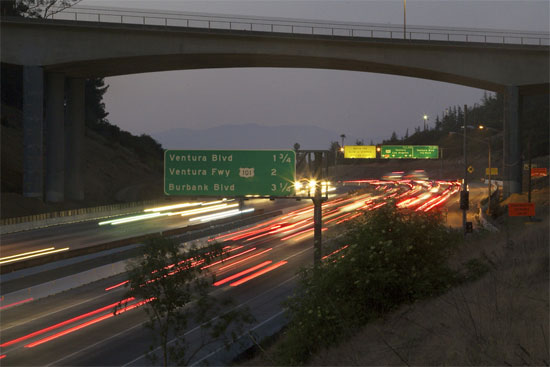
Afternoon rush hour speeds haven’t changed much but the worst traffic may be ending sooner.
Afternoon rush hour speeds on the northbound 405 Freeway through the Sepulveda Pass appear to have stayed relatively constant—or perhaps gotten a bit slower—in the year following the full opening of a new carpool lane at the heart of a $1 billion-plus improvement project, according to a recent two-week sample by a traffic monitoring firm.
But given the increase in cars on the road due to an improving economy, just staying even may be an accomplishment, according to analysts at INRIX, which monitors traffic for clients including government agencies and media organizations.
The firm looked at afternoon travel times on the northbound 405 between the 10 and the 101 this September, when the new carpool lane was fully open for business, and the same period last year, when only a 1.7-mile stretch of the new lane was in use. INRIX did not have a measurement of travel times during the same period in 2009, before the project started. Caltrans and Metro said they were unable to immediately provide their own travel time statistics for either the 2013 or 2014 period, or for the same period in 2009, before the project began.
The INRIX snapshot, while far from definitive, is significant because it offers the first glimpse of how the long-running project may be affecting motorists in one of the nation’s most notorious traffic hotspots.
The sampling took place on weekdays during the second and third weeks of September. It found that drivers on the northbound 405 between 4 p.m. and 7 p.m. took 35 minutes to travel between the 10 and the 101—a rate of about 16 miles per hour. That’s a minute slower than the same period last year, despite the full opening of the 10-mile carpool lane this May as part of the 405 Project.
“The data shows that nothing’s changed despite the investment that’s been made,” said Jim Bak, director of INRIX.
However, on the positive side, the most congested part of the rush hour appears to be ending earlier, Bak said. Travel times in the sample weeks averaged just 23 minutes during the final hour of the rush period, compared to 28 minutes a year ago.
And things could be worse. The freeway is doing a good job of managing a regional surge in traffic, Bak said. “L.A. County had the fastest year-over-year growth in employment since the recession began in 2007,” Bak said. “You’ve got people going back to work in good numbers. People are spending money, they’re going to restaurants—all that stuff contributes to more traffic on the roads.”
The finding that speeds appear to have remained level despite the increase in traffic is a sign of the project’s success, Metro spokesman Dave Sotero said. Caltrans, Metro’s partner on the 405 Project, estimates that the carpool lane handles 1,600 cars per hour during peak travel times. “If you didn’t have that extra lane, all those cars would be competing for five lanes instead of six,” Sotero said.
What’s more, the 405 Project’s benefits go beyond traffic speeds, Sotero said. The project enhanced safety by rebuilding three bridges to better withstand earthquakes and by creating additional shoulder space on the freeway, he said, while reconfigured on- and off-ramps have increased capacity and improved traffic flow. Sotero said the project never was expected to be a panacea for rush hour traffic.
“You can’t escape the fact that carpool lanes are going to fill up during peak periods,” Sotero said. “What carpool lanes do is reduce the duration and severity of traffic.”
The 405 is one of the busiest and most congested roadways in the world. According to a Metro estimate from 2011, it handles 300,000 vehicles per day. INRIX’s Bak said that congestion on the 405 is emblematic of a national problem that’s made worse by deteriorating infrastructure. Highway improvements help, he said, but every option—from better public transit to improved technology for the timing of traffic lights—should be on the table, he said.
Metro’s Sepulveda Pass Transit Corridor project—which could include a high-capacity rail line connecting the San Fernando Valley and the Westside—may be an option for improving transportation along the 405 over the long term, if funding for the project can be identified.
But shorter-term fixes also are on the way. Metro will debut an express bus line in December that will take advantage of the 405’s new carpool lane to create a nonstop transit connection between the Valley and Westside.
“We are taking an ‘all of the above’ strategy to improve mobility in the Sepulveda Pass,” Sotero said. Carpool lanes are one step toward Metro’s main goal, which “isn’t to move more vehicles, but to move more people.”
For now, though, Metro or Caltrans measurements toward that goal are unavailable, as far as the 405 Project’s performance is concerned. Caltrans plans to collect such data but has not yet installed the necessary road sensors to do so, said Lauren Wonder, spokeswoman for the agency.
For its part, INRIX, using technology developed by Microsoft, combines road sensor data with crowd-sourced data from vehicle navigation systems and mobile devices such as smart phones. In cases where there are no road sensors the company can still calculate speeds within a two mile-per-hour margin of error, Bak said. INRIX contracts with media organizations, automobile manufacturers and 40 state transportation departments to provide real time traffic data and assess long term traffic trends.
A more detailed examination is expected in March or April of 2015 when INRIX releases its Traffic Scorecard—an annual report on traffic congestion in the United States and parts of Europe.
Posted 10/8/14






